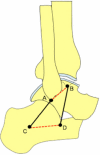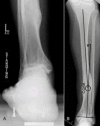Total ankle replacement: why, when and how?
- PMID: 21045984
- PMCID: PMC2958283
Total ankle replacement: why, when and how?
Abstract
Total ankle replacement (TAR) was first attempted in the 1970s, but poor results led to its being considered inferior to ankle fusion until the late 1980s and early 1990s. By that time, newer designs which more closely replicated the natural anatomy of the ankle, showed improved clinical outcomes. Currently, even though controversy still exists about the effectiveness of TAR compared to ankle fusion, TAR has shown promising mid-term results and should no longer be considered an experimental procedure. Factors related to improved TAR outcomes include: 1) better patient selection, 2) more precise knowledge and replication of ankle biomechanics, 3) the introduction of less-constrained designs with reduced bone resection and no need for cementation, and 4) greater awareness of soft-tissue balance and component alignment. When TAR is performed, a thorough knowledge of ankle anatomy, pathologic anatomy and biomechanics is needed along with a careful pre-operative plan. These are fundamental in obtaining durable and predictable outcomes. The aim of this paper is to outline these aspects through a literature review.
Figures







Similar articles
-
Current Concepts Regarding Total Ankle Replacement as a Viable Treatment Option for Advanced Ankle Arthritis: What You Need to Know.Clin Podiatr Med Surg. 2017 Oct;34(4):515-527. doi: 10.1016/j.cpm.2017.05.008. Epub 2017 Jul 14. Clin Podiatr Med Surg. 2017. PMID: 28867057 Review.
-
A brief history of total ankle replacement and a review of the current status.Med Eng Phys. 2007 Dec;29(10):1056-64. doi: 10.1016/j.medengphy.2006.11.009. Epub 2007 Feb 14. Med Eng Phys. 2007. PMID: 17300976 Review.
-
Total Replacement of Varus Ankle: Three-Component Prosthesis Design.Foot Ankle Clin. 2019 Jun;24(2):305-324. doi: 10.1016/j.fcl.2019.02.005. Epub 2019 Mar 29. Foot Ankle Clin. 2019. PMID: 31036270 Review.
-
Can a Three-Component Prosthesis be Used for Conversion of Painful Ankle Arthrodesis to Total Ankle Replacement?Clin Orthop Relat Res. 2017 Sep;475(9):2283-2294. doi: 10.1007/s11999-017-5343-4. Epub 2017 Apr 19. Clin Orthop Relat Res. 2017. PMID: 28425054 Free PMC article.
-
Prospective Randomized Trial Comparing Mobile-Bearing and Fixed-Bearing Total Ankle Replacement.Foot Ankle Int. 2019 Nov;40(11):1239-1248. doi: 10.1177/1071100719879680. Epub 2019 Sep 27. Foot Ankle Int. 2019. PMID: 31561727 Clinical Trial.
Cited by
-
Arthroscopic ankle arthrodesis: a review.Curr Rev Musculoskelet Med. 2012 Jun;5(2):151-5. doi: 10.1007/s12178-012-9119-x. Curr Rev Musculoskelet Med. 2012. PMID: 22430861 Free PMC article.
-
The Effect of Tranexamic Acid on the Outcome of Total Ankle Replacement.Cureus. 2022 Jul 9;14(7):e26706. doi: 10.7759/cureus.26706. eCollection 2022 Jul. Cureus. 2022. PMID: 35959184 Free PMC article.
-
A numerical study on stress distribution across the ankle joint: Effects of material distribution of bone, muscle force and ligaments.J Orthop. 2017 May 17;14(3):329-335. doi: 10.1016/j.jor.2017.05.003. eCollection 2017 Sep. J Orthop. 2017. PMID: 28559650 Free PMC article.
-
Implications of obesity in patients with foot and ankle pathology.World J Orthop. 2023 May 18;14(5):294-301. doi: 10.5312/wjo.v14.i5.294. eCollection 2023 May 18. World J Orthop. 2023. PMID: 37304200 Free PMC article. Review.
-
Combined Intramedullary Nailing and Interfragmentary Screws in Distal Tibial Fractures With Articular Extension.Cureus. 2025 Jun 30;17(6):e87033. doi: 10.7759/cureus.87033. eCollection 2025 Jun. Cureus. 2025. PMID: 40741563 Free PMC article.
References
-
- Vickerstaff JA, Miles AW, Cunningham JL. A brief history of total ankle replacement and a review of the current status. Med Eng Phys. 2007;29(10):1056–64. Dec. - PubMed
-
- Chou LB, Coughlin MT, Hansen S, Jr, Haskell A, Lundeen G, Saltzman CL, Mann RA. Osteoarthritis of the ankle: the role of arthroplasty. J Am Acad Orthop Surg. 2008;16(5):249–59. May. - PubMed
-
- Inman VT. The joints of the ankle. Baltimore: Williams&Wilkins; 1979.
-
- Isman RE, Inman VT. Anthropometric studies of the human foot and ankle. Bull Pros Res. 1969;10:97–129.
-
- Bottlang M, Marsh JL, Brown TD. Articulated external fixation of the ankle: minimizing motion resistance by accurate axis alignment. J Biomech. 1999;32:63–70. - PubMed
Publication types
MeSH terms
LinkOut - more resources
Full Text Sources
Other Literature Sources
Medical
